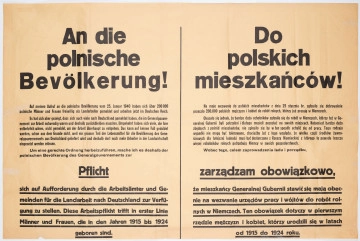
Amber pendant
1050 — 1200
National Museum in Szczecin
Part of the collection: Memorabilia related to the November and January Uprisings in the Lublin Region
The period of the First World War paradoxically brought Poles more freedom than the time of the Partitions, especially in the territories occupied by the Russians. In 1915, the Russian army withdrew from the Polish lands and the Austrians entered. This resulted in unprecedented freedom in the social and cultural life of many cities, including Lublin. Although independence was regained in 1918, the date from which it was possible to at least celebrate national festivities was 1915. Preparations were then under way to commemorate the anniversaries of the November and January Uprisings, in the latter case with the participation of veterans of 1863.
A considerable relaxation of censorship made it possible to print commemorative posters and leaflets, which were hung on fences and posts to inform people about the celebrations. Such posters with patriotic content were very necessary. They strengthened identity, educated and united Poles.
Prints with patriotic motifs were produced throughout the partition period. They literally or symbolically showed the fate of Poland - Motherland as a crucified woman. Another popular image was that of a white eagle defending its nest against three black ravens, symbolising the three invading powers. Many works were by anonymous artists.
Apart from leaflets, a metal badge in the form of an oval medallion with an inscription, crowned with the figure of an eagle with outstretched wings, was made.
Author / creator
Dimensions
cały obiekt: height: 29 cm, width: 40 cm
Object type
leaflet
Technique
Material
paper
Creation time / dating
Creation / finding place
Owner
The National Museum in Lublin
Identification number
Location / status

Słowianie
1050 — 1200
National Museum in Szczecin

unknown
1940
National Museum in Lublin

Kietlicz-Rayski, Konstanty
1915
National Museum in Lublin
DISCOVER this TOPIC
Castle Museum in Łańcut
DISCOVER this PATH
Educational path
0/500

We use cookies to make it easier for you to use our website and for statistical purposes. You can manage cookies by changing the settings of your web browser. More information in the Privacy Policy.
We use cookies to make it easier for you to use our website and for statistical purposes. You can manage cookies by changing the settings of your web browser. More information in the Privacy Policy.
Manage cookies:
This type of cookies is necessary for the website to function. You can change your browser settings to block them, but then the website will not work properly.
WYMAGANE
They are used to measure user engagement and generate statistics about the website to better understand how it is used. If you block this type of cookies, we will not be able to collect information about the use of the website and we will not be able to monitor its performance.